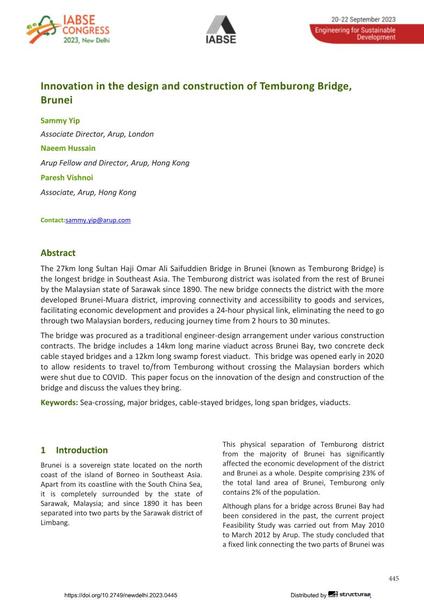Innovation in the design and construction of Temburong Bridge, Brunei

|
|
|||||||||||
Bibliografische Angaben
| Autor(en): |
Sammy Yip
(Associate Director, Arup, London)
Naeem Hussain (Arup Fellow and Director, Arup, Hong Kong) Paresh Vishnoi (Associate, Arup, Hong Kong) |
||||
|---|---|---|---|---|---|
| Medium: | Tagungsbeitrag | ||||
| Sprache(n): | Englisch | ||||
| Tagung: | IABSE Congress: Engineering for Sustainable Development, New Delhi, India, 20-22 September 2023 | ||||
| Veröffentlicht in: | IABSE Congress New Delhi 2023 | ||||
|
|||||
| Seite(n): | 445-452 | ||||
| Anzahl der Seiten (im PDF): | 8 | ||||
| DOI: | 10.2749/newdelhi.2023.0445 | ||||
| Abstrakt: |
The 27km long Sultan Haji Omar Ali Saifuddien Bridge in Brunei (known as Temburong Bridge) is the longest bridge in Southeast Asia. The Temburong district was isolated from the rest of Brunei by the Malaysian state of Sarawak since 1890. The new bridge connects the district with the more developed Brunei-Muara district, improving connectivity and accessibility to goods and services, facilitating economic development and provides a 24-hour physical link, eliminating the need to go through two Malaysian borders, reducing journey time from 2 hours to 30 minutes. The bridge was procured as a traditional engineer-design arrangement under various construction contracts. The bridge includes a 14km long marine viaduct across Brunei Bay, two concrete deck cable stayed bridges and a 12km long swamp forest viaduct. This bridge was opened early in 2020 to allow residents to travel to/from Temburong without crossing the Malaysian borders which were shut due to COVID. This paper focus on the innovation of the design and construction of the bridge and discuss the values they bring. |
||||
| Stichwörter: |
Viadukte Schrägseilbrücken Meeresüberquerung
|
||||
